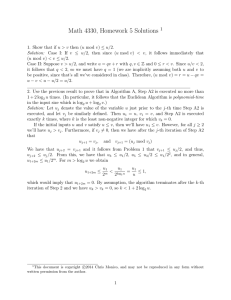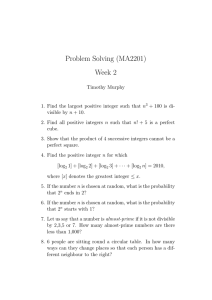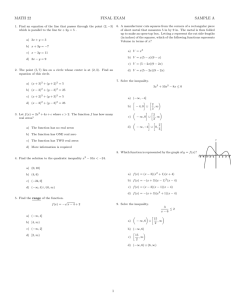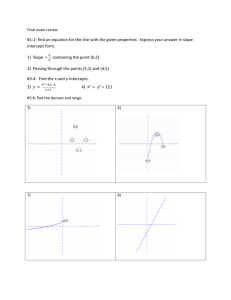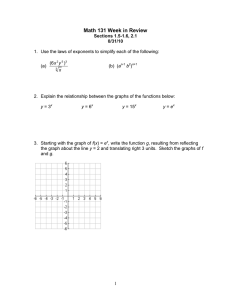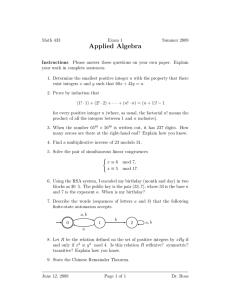INTEGERS 11 (2011) #L14 THE INTRINSIC PERIODIC BEHAVIOUR OF SEQUENCES
advertisement
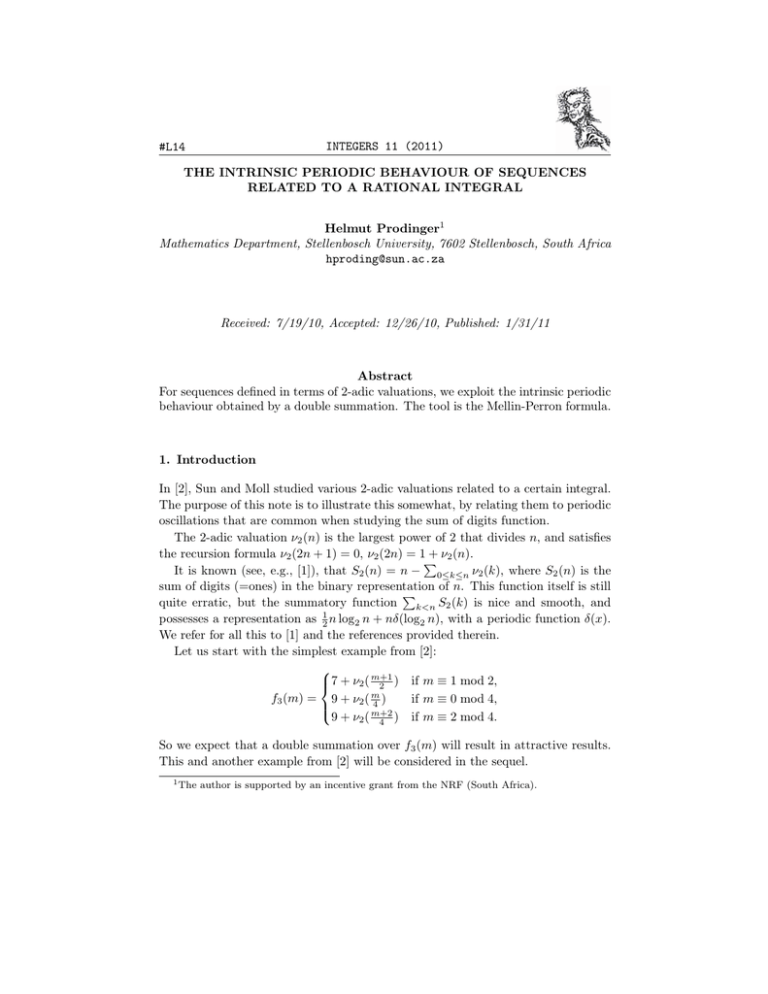
INTEGERS 11 (2011) #L14 THE INTRINSIC PERIODIC BEHAVIOUR OF SEQUENCES RELATED TO A RATIONAL INTEGRAL Helmut Prodinger1 Mathematics Department, Stellenbosch University, 7602 Stellenbosch, South Africa hproding@sun.ac.za Received: 7/19/10, Accepted: 12/26/10, Published: 1/31/11 Abstract For sequences defined in terms of 2-adic valuations, we exploit the intrinsic periodic behaviour obtained by a double summation. The tool is the Mellin-Perron formula. 1. Introduction In [2], Sun and Moll studied various 2-adic valuations related to a certain integral. The purpose of this note is to illustrate this somewhat, by relating them to periodic oscillations that are common when studying the sum of digits function. The 2-adic valuation ν2 (n) is the largest power of 2 that divides n, and satisfies the recursion formula ν2 (2n + 1) = 0, ν2 (2n) = 1 + ν2 (n). � It is known (see, e.g., [1]), that S2 (n) = n − 0≤k≤n ν2 (k), where S2 (n) is the sum of digits (=ones) in the binary representation of n. This function itself is still � quite erratic, but the summatory function k<n S2 (k) is nice and smooth, and possesses a representation as 12 n log2 n + nδ(log2 n), with a periodic function δ(x). We refer for all this to [1] and the references provided therein. Let us start with the simplest example from [2]: m+1 7 + ν2 ( 2 ) if m ≡ 1 mod 2, f3 (m) = 9 + ν2 ( m if m ≡ 0 mod 4, 4) 9 + ν2 ( m+2 ) if m ≡ 2 mod 4. 4 So we expect that a double summation over f3 (m) will result in attractive results. This and another example from [2] will be considered in the sequel. 1 The author is supported by an incentive grant from the NRF (South Africa). 2 INTEGERS: 11 (2011) 2. Mellin-Perron Approach A double summation can be expressed as a single sum via � 1≤k<n f3 (k)(n − k) = n � 1≤k<n � k� f3 (k) 1 − . n The Mellin-Perron approach, as developed in [1], provides an integral representation for it: c+i∞ � � � k� 1 ds f3 (k) 1 − = F3 (s)ns , n 2πi s(s + 1) 1≤k<n c−i∞ where � f3 (n) ns F3 (s) = n≥1 is the generating Dirichlet series, and c is any real number large enough, so that the series converges. F3 (s) = � f3 (n) ns n≥1 = � 7 + ν2 (n + 1) � 9 + ν2 (n) � 9 + ν2 (n + 1) + + (2n + 1)s (4n)s (4n + 2)s n≥0 = 9ζ(s) − 2 n≥1 � n≥0 n≥0 � ν2 (n + 1) � ν2 (n) � ν2 (n + 1) 1 + + + (2n + 1)s (2n + 1)s (4n)s (4n + 2)s n≥0 n≥1 n≥0 � ν2 (n + 1) � ν2 (n) −s = 9ζ(s) − 2ζ(s) + 21−s ζ(s) + (1 + 2−s ) + 4 . (2n + 1)s ns n≥0 Now we compute (as many people did before) � ν2 (n) � 1 + ν2 (n) = . ns (2n)s n≥1 So n≥1 � ν2 (n) 2−s ζ(s) = . ns 1 − 2−s n≥1 n≥1 3 INTEGERS: 11 (2011) The remaining sum we treat like this: � ν2 (n) � ν2 (n) 1 �−s = 1− s s (2n − 1) (2n) 2n n≥1 n≥1 � � � s + k − 1 � ν2 (n) = (2n)s+k k n≥1 k≥0 � � � s+k−1 1 = ζ(s + k). s+k s+k k 2 (2 − 1) � k≥0 Summarizing: 8−s ζ(s) F3 (s) = 7ζ(s) + 21−s ζ(s) + 1 − 2−s � �s + k − 1� 1 + (1 + 2−s ) ζ(s + k). 2s+k (2s+k − 1) k k≥0 The classic procedure is now to shift the line of integration to the left and collect residues. Because of the presence of the zeta function, we cannot shift the line too far; and because of the functions ζ(s + k), we cannot hope for an exact formula, but only for an asymptotic one. More details about this procedure are to be found in the article [1]. We must collect the residues of F3 (s) ns s(s + 1) at s = 1 and at s = 0. Fortunately, this can be done by a computer, and we have collected so far: 9n 3 7 3 3 − log2 n − − log2 π + . 2 2 4 2 2 log 2 But there are also poles at s = χk = 2πik log 2 , with residues ζ(χk ) e2πik·log2 n . log 2 · χk (χk + 1) Traditionally, one collects them into a periodic function: φ(x) = 1 � ζ(χk ) e2πikx . log 2 χk (χk + 1) k�=0 Multiplying all the contributions by n, we found an asymptotic expansion for the doubly iterated sum. The remainder term stems from the fact that we shift the line of integration to �s = − 14 , as in [1]. 4 INTEGERS: 11 (2011) Theorem 1 � 1≤k<n 9n2 3n 3n − log2 n − log2 π 2 2 2 f3 (k)(n − k) = 7n 3n + + nφ(log2 n) + O(n3/4 ). 4 2 log 2 − 0.1 1000 2000 3000 4000 5000 0 –0.1 –0.2 –0.3 –0.4 Figure 1: 1 n � 1≤k<n f3 (k)(n − k) − 9n 2 + Now let us move to the next example from 14 + ν2 ( m+2 4 ) m+1 13 + ν2 ( 4 ) f5 (m) = 13 + ν2 ( m+3 4 ) m 16 + ν2 ( 8 ) 16 + ν ( m+4 ) 2 8 3 2 log2 n + 7 4 + 3 2 log2 π − [2]: if if if if if m ≡ 2 mod 4, m ≡ 3 mod 4, m ≡ 1 mod 4, m ≡ 0 mod 8, m ≡ 4 mod 8. As before, we compute the generating Dirichlet series: � f5 (n) � −2 + ν2 (n + 1) � −3 + ν2 (n + 1) = 16ζ(s) + + s n (4n + 2)s (4n + 3)s n≥1 n≥0 n≥0 � −3 + ν2 (n + 1) � ν2 (n) � ν2 (n + 1) + + + (4n + 1)s (8n)s (8n + 4)s n≥0 n≥1 n≥0 3 2 log 2 5 INTEGERS: 11 (2011) 0.05 1000 2000 3000 4000 5000 0 –0.05 –0.1 Figure 2: The periodic function φ(log2 n), drawn from the first 200 Fourier coefficients. = 16ζ(s) − 3ζ(s) + 2 4−s ζ(s) + 2−s ζ(s) + + � n≥1 � n≥1 � ν2 (n) ν2 (n) + s (4n − 2) (4n − 1)s n≥1 � ν2 (n) � ν2 (n) ν2 (n) + 8−s + s (4n − 3) ns (8n − 4)s n≥1 n≥1 = 13ζ(s) + 2 4−s ζ(s) + 2−s ζ(s) + (2−s + 4−s ) � n≥1 + � n≥1 ν2 (n) + (4n − 1)s � n≥1 ν2 (n) (2n − 1)s ν2 (n) 16 + ζ(s) (4n − 3)s 1 − 2−s −s 16−s = 13ζ(s) + 2 4−s ζ(s) + 2−s ζ(s) + ζ(s) 1 − 2−s � � � s+k−1 1 + (2−s + 4−s ) ζ(s + k) s+k s+k 2 (2 − 1) k k≥0 � �s + k − 1� 1 + 3k + ζ(s + k). k 4s+k (4s+k − 1) k≥0 6 INTEGERS: 11 (2011) The collected residues of F5 (s)ns at s = 1 and s = 0 are: s(s + 1) 22n 29 2 − 2 log2 n − 2 log2 π − + . 3 12 log 2 The periodic function has this time period log4 n. Theorem 2 We have � 1≤k<n f5 (k)(n − k) = − 22n2 − 2n log2 n − 2n log2 π 3 29n 2n + + nψ(log4 n) + O(n3/4 ). 12 log 2 Other examples, related to f7 (m), f9 (m), . . . , can be treated in the same style, but the generating Dirichlet series become more cumbersome. References [1] P. Flajolet, P. Grabner, P. Kirschenhofer, H. Prodinger, and R. F. Tichy. Mellin transforms and asymptotics: Digital sums. Theoretical Computer Science, 123:291–314, 1994. [2] X. Sun and V. H. Moll. A binary tree representation for the 2-adic valuation of a sequence arising from a rational integral. Integers, 10:211–222, 2010.

